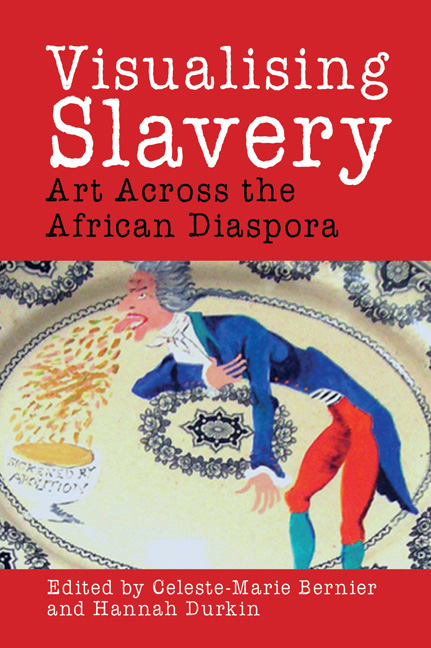Book contents
- Frontmatter
- Dedication
- Contents
- List of Illustrations
- Acknowledgements
- Introduction: ‘Inside the Invisible’: African Diasporic Artists Visualise Transatlantic Slavery
- Part I Slavery and Memory in Contemporary African Diasporic Art
- Part II Historical Iconography and Visualising Transatlantic Slavery
- Chapter 6 The Chattel Record: Visualising the Archive in Diasporan Art
- Chapter 7 Henry Box Brown, African Atlantic Artists and Radical Interventions
- Chapter 8 Uncle Tom and the Problem of ‘Soft’ Resistance to Slavery
- Chapter 9 The After-Image: Frederick Douglass in Visual Culture
- Part III African Diasporic Monuments and Memorialisation
- Part IV Contemporary Legacies in African Diasporic Art
- Afterword: Against the Grain: Contingency and Found Objects
- Notes on Contributors
- Index
- Platesection
Chapter 9 - The After-Image: Frederick Douglass in Visual Culture
from Part II - Historical Iconography and Visualising Transatlantic Slavery
- Frontmatter
- Dedication
- Contents
- List of Illustrations
- Acknowledgements
- Introduction: ‘Inside the Invisible’: African Diasporic Artists Visualise Transatlantic Slavery
- Part I Slavery and Memory in Contemporary African Diasporic Art
- Part II Historical Iconography and Visualising Transatlantic Slavery
- Chapter 6 The Chattel Record: Visualising the Archive in Diasporan Art
- Chapter 7 Henry Box Brown, African Atlantic Artists and Radical Interventions
- Chapter 8 Uncle Tom and the Problem of ‘Soft’ Resistance to Slavery
- Chapter 9 The After-Image: Frederick Douglass in Visual Culture
- Part III African Diasporic Monuments and Memorialisation
- Part IV Contemporary Legacies in African Diasporic Art
- Afterword: Against the Grain: Contingency and Found Objects
- Notes on Contributors
- Index
- Platesection
Summary
By the time of his death in 1895, Frederick Douglass had sat for approximately 160 different photographs. This makes him the most photographed American of the nineteenth century, rather than Abraham Lincoln, Walt Whitman or General Custer (all previously claimed by scholars as the century's most photographed Americans). This means that, even as African American men were considered subhuman by many white Americans, Douglass was visually famous. He was immediately recognisable to millions when Americans circulated his photographs as portrait engravings in the press, published them as lithographs in books, and collected and displayed them in their carte-de-visite (CDV) albums and homes.
Douglass used these photographs to visualise the self and the country in transition, enacting a shift in his persona after the Civil War and Emancipation. Before the war, Douglass clenches his fist in photographs, as though in the act of fighting. After emancipation, the fist unclenches. In another shift, Douglass often makes direct eye contact in photographs before the war, staring challengingly back at the viewer. After Emancipation, he tends to use a classic statesman three-quarter pose. In photographs, we see Douglass the fighter and fugitive transformed into Douglass the citizen and great American. As Douglass himself phrased it in the title to his second autobiography, it represented a transition from bondage to freedom. In fact, Douglass even revised his visual persona with the publication of each new autobiography, knowing that the first page of the book would feature a frontispiece portrait. The Douglass of the Narrative of the Life of Frederick Douglass (1845) era is clean-shaven with a side parting. When he published My Bondage and My Freedom (1855), he had grown a goatee and replaced the side-parting with a longer, Afro-like style. This version of Douglass is the one we should associate with his most radical years, when he advocated violent resistance to slave catchers, worked with John Brown and pushed for Black soldiers to fight in the Union Army. He maintained this look until a few months after the Emancipation Proclamation (1863), then was beardless with a moustache for about 15 years. In the late 1870s, soon before he published his third autobiography, The Life and Times of Frederick Douglass (1881), he reinvented himself one last time by growing a full beard and longer hair.
- Type
- Chapter
- Information
- Visualising SlaveryArt Across the African Diaspora, pp. 129 - 152Publisher: Liverpool University PressPrint publication year: 2016

